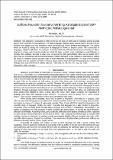| dc.description.abstract | This research is conducted in order to find out the kinds of suffix used in narrative writing at grade eight of SMP Methodist Pematangsiantar. In English language, Halliday stated that the level is derived from the smallest to the biggest one, from morpheme, word, phrase (group), clause, sentence and paragraph. The various levels are found by having the construction of language or known as English syntax. The construction of language is related to affixation. According to McCarthy (2006:84), Affixation is the process whereby an affix is attached to a base, which may be simple (as in full, the base to which –ness is attached to yield fullness), or complex (like meditate, the base to which pre- is attached to yield premeditate). Affix can be divided into 2 types, they are inflectional and derivational affixes. Problem discussed in this research is what kinds of suffixes are found in narrative writing at grade eight of SMP Methodist Pematangsiantar? The data of this research were taken from the students’ narrative writing at grade eight of SMP Methodist Pematangsiantar. Finally, the findings show: that some kinds of suffixes used are: -ed/d, s/es, -ly, -al, -ion, -en, -ing, -ity, -ment. | en_US |

